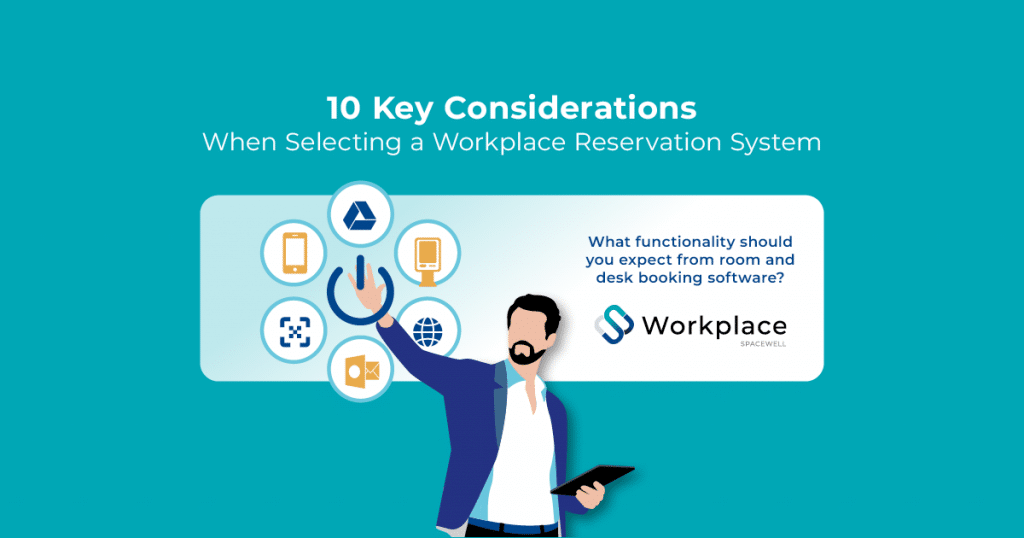What Should You Expect in Room and Desk Booking Software for the Workplace?
In today’s hybrid workplace era, where many employees may be split between in-office and remote locations, it is essential that any business looking to stay ahead of the curve have a well-designed workplace reservation system in place. Providing a ‘commute-worthy’ workplace experience includes creating a flexible work environment that encourages collaboration and productivity while providing access to the right tools and resources. One of the most important tools in this context is room and desk booking software. This blog and associated infographic discuss the essential functionality and capabilities workplace managers and employees should expect when searching for booking software to meet their needs.

Free infographic
10 Key Considerations When Selecting a Workplace Reservation System
10 Key Considerations When Selecting a Workplace Reservation System
Essential Capabilities for a Workplace Reservation System
From an Employee Perspective:
- Ease of Booking
Booking a desk, room, or service through a range of various touchpoints should be intuitive and straightforward. Depending on their personal preferences and location, employees should be able to book remotely (using their smartphone, for example, or a web interface with Google & Outlook sync) or on the spot (using large touchscreens such as kiosks placed in high-traffic areas, room panels outside meeting spaces, or quick QR code scanning).
- One-Stop Shop
Employees should be able to book everything they require in one go, including spaces, services, parking spots, and amenities. The one-stop-shop concept saves employee time and creates a seamless booking experience.
- Colleague Discovery
The ability to find colleagues based on their reservations is a useful feature for group collaboration. Finding office locations and proximity to colleagues and teams for group work is efficient when it is integrated into the workplace reservation system.
- Digital Plan Interface and Efficient Filtering
Digital floor plans with information overlay (occupancy, comfort, air quality) are another helpful feature to improve room and desk booking software effectiveness. The interface should have multiple filters to refine the search process, offering diverse options for location, space type and size, availability, and amenities.
From a Workplace Manager/Facility Manager Perspective:
- Group Bookings
Group bookings facilitate collaborative work that benefits from close proximity to team members. A workplace reservation system should offer tools that enable easy setting up of group bookings.
- IWMS Integration
Smooth management and maintenance of facilities often involves a mix of soft/hard services. Reservation software should fully integrate with a broader facility management platform (IWMS or Integrated Workplace Management System) for aspects such as work orders, stock management, and reception services, to streamline visitors’ check-in process and ensure seamless operations.
- Sensor Data Integration
Sensor data integration (optional) allows for increased transparency, better-informed choices, and a more personalized experience in the workplace. Networked sensors provide live information, giving occupants direct access to real-time data about space occupancy and ambient conditions such as room temperature and air quality. With that information at their fingertips, employees can instantly choose the spaces that suit them the best.
- Brain Rules
Booking software should have the capacity to set configurable rules to improve resource usage and the occupant experience. For example, the ability to create rules to auto-cancel reservations when rooms or desks stay empty. Or to receive notifications about upcoming meetings, comfort levels, and more.
- Occupancy Intelligence
Finally, the structure of the modern office has changed, and effective occupancy management is critical. Using booking software to analyze the occupancy and improvement of workspace utilization is vital to workplace management. It aids in weekly, monthly, and long-term occupancy visualization and analysis.
Choosing a Workplace Reservation System – In Conclusion
The deployment of a robust workplace reservation system has become the norm for most organizations. However, selecting and choosing the right room and desk booking software that maximizes productivity and operational efficiencies requires more than straightforward functionality. Interactive elements like sensor integration, occupancy intelligence, and brain rules capability should be essential tools to enhance workplace development. A workplace booking system should be seamlessly integrated with workplace operations to offer an excellent user experience and improve company performance.






